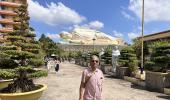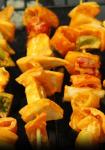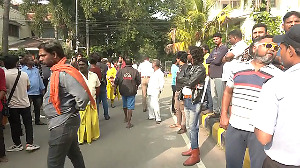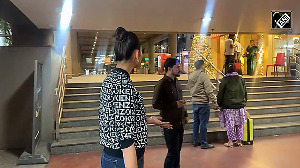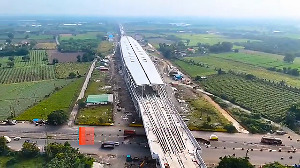'I am smitten with Tokyo's eclectic mix of modern cosmopolitanism and old world Japan,' confesses Dinesh Raheja.

My heart is sinking in the Land of the Rising Sun.
It's my last day in Tokyo, a city I have fallen in love with in the six days I have spent here. Later in the day, I have to board a flight to Osaka en route to Kyoto.
I look longingly at the view of the Tokyo skyline from my 11th-floor hotel room window in Kayabacho, a sparkling-clean business district. I can see the IBM building from one angle. On another side: Wide, clean sidewalks overlooking a river in which big white birds swoop down to fish.
There is a cherry blossom tree in full extravagant bloom right just outside our hotel. The sight is spectacular but calming -- delicate snow-white flowers bunched against the blue spring sky.
I am smitten with Tokyo's eclectic mix of modern cosmopolitanism and old world Japan. The Imperial Palace grounds, with its ruins of the old Edo castle and watch towers, the Sensō-ji Buddhist temple and its immense vermilion-red-and-black paper lantern, the Meiji Jingu shrine, a Shinto temple with its one lakh trees, all contrast sharply with a tableaux of modern Tokyo landmarks like the Skytree, the Asahi Beer buildings and the glitzy, hi-fashion hubs of Ginza and Shinjuku.
On my final day in the city, I want to do something that further jazzes up my Tokyo experience. Absentmindedly eating the unchanging options of the hotel breakfast -- scrambled eggs, lettuce salad, croissant and jam, served with black coffee that I douse with a quarter cup of milk to take the edge off the bitterness -- I am at loggerheads with myself, unable to make a choice of how to spend the day.
Choices, choices, choices. A staid tea ceremony in a tatami-mat room at Imperial Hotel with prior reservation or a visceral visit to the Tsukiji fish market in Central Tokyo?
Despite being a vegetarian, I choose the latter for the novelty and wacky quotient of the experience. And boy, am I amply rewarded.

Peaceful Shinto shrines and Buddhist temples are aplenty in Tokyo. Tsukiji market is named after an impressive shrine which I visit before heading out to the bazaar.

Rather surprisingly, Tsukiji is also a produce market, selling expensive knives that look weapon-grade (Kill Bill, anyone?), besides vegetables, fruits, outsized Shiitake mushrooms and my favourite wasabi.

Most amazingly, unlike the other fish markets I have been to, the Tsukiji fish market is sans smells and cats. And not a single fly! How do the Japanese do it?
There are stalls with serpentine queues of people waiting to have fresh sushi and ice cream. I am unable to stomach an ice cream after the sight of all those varieties of sliced, diced, shredded and strung-up seafood.

I turned vegetarian in 1990 and the sight of a fish with a hook in its mouth makes me forego my daily routine of 'a new ice cream flavour a day' in Tokyo (black sesame and matcha are my favourites).
Incidentally, when I ask for a vegetarian burger at a Moss Burger outlet on another day, the helpful girl at the counter asks me if shrimp is okay. I smile and spontaneously shake my head vigorously and she goes "Ohohoh!" in understanding.

I had found my way to the Tsukiji fish market street easily enough, but found it difficult to leave that soon. I get to see the most exotic and colourful array of sea life on display -- shrimp, eels, squid, cod, lobsters and crabs. There are immense live crabs behind glass showcases. And a vendor dexterously tossing up squid jerky, like a salad.
What I was most shocked by... the jaw-dropping price tags on those crabs!

For lunch, I make a trip across town to Takeshita street where I had an ingeniously served crepe rolled up like a huge cone with fruits and cream tucked inside. It was scrumptious, definitely more so than the rather strange bubble drink I had as an accompaniment. It's that rare cold drink that I don't finish.

Takeshita street is crowded, narrow, pedestrian-only with a fun, young vibe. I was gobsmacked by the sight of a girl with candy coloured hair outside a candy shop. And a cat cafe! Takeshita street and neighbouring Harajuku are famous for attracting the young Japanese who love dressing up like their favourite manga or anime character.
The next day, I leave Tokyo for a whirlwind tour of Osaka (a modern metropolis) and Kyoto (abrim with exquisite gardens and shrines) and even bump into a geisha hurrying down the streets in Kyoto.
But I can't say sayonara to Japan without a visit to Nara, a small town near Kyoto and the capital of Japan for a brief period in the 8th century.

I check out of my Kyoto hotel, and undertake an hour-long train journey to Nara followed by a short bus ride, which brings me to the Todai-ji temple.
Adjoining it is Nara Park and almost as soon as I alight from the bus, I am greeted by the town's famous tame deer roaming freely.
In the park, I purchase packets of crackers (shika senbei) for 150 yen each to feed the deer; and the hungry herbivores actively pursue me the moment I make the purchase.

They appear harmless but are not docile. One aggressive deer even snatches up a paper map from a shrieking tourist and raises many laughs. Some have learnt to bow to visitors.
I feed a few deer at Nara Park but feel compelled to joke with the others, "Oh deer, I have none for you."
The centuries-old Todai-ji is one of Japan's best-known temples and has an enormous nearly 50-foot tall bronze statue of Lord Buddha. Todai-ji temple's main hall -- called the Daibutsuden -- is the world's largest wooden building. I light a candle and pray for family and friends back home.

On the way back, I stop at Kofuku-ji, a five-storey wooden pagoda, which is Japan's second tallest. The huge statue of the Boddhisattva supplies an atmosphere of serenity.
After some last-minute shopping for gifts and Japanese sweets at a massive store, I hit the street again till I hear someone exclaim, "Is this bag yours?" I had forgotten my bag ,which contained my passport, and the little old lady at the check-out counter had come running out on the road to return it.
I retrace the journey back to the Kyoto hotel to pick up my bags and, though I have signed out, they helpfully call me a cab. It's back to Osaka and my flight home.

